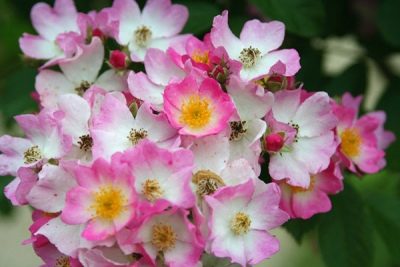
- Authors: Bentall
- Name synonyms: Ballerina
- Breeding year: 1937
- Group: ground cover
- The main color of the flower: pink
- Flower shape: flat
- Flower size: small
- Diameter, cm: 4-5
- Flower type by number of petals: simple
- Scent: with hints of musk
The Ballerina rose variety, bred in 1937 in Germany, was the result of the selection activities of the Bentall spouses. It attracts gardeners all over the world with its long flowering, strong immunity and versatility of use.
Description of the variety
The Ballerina rose variety, aka Ballerina, is a hybrid of musk varieties belonging to the ground cover group. In height, the bush reaches 70-90 centimeters, and in diameter does not exceed 0.8-1.4 meters. Erect shoots with medium leaves are covered with large thorns. Elongated emerald-colored leaf blades have a glossy surface and sharp tips. A feature of the Ballerina variety is that, without pruning, the plant takes on a spherical shape, ideal for creating a hedge or decorating borders.
During the flowering period, the rose bush is covered with small flowers with a white center and petals, the shade of which changes from dark pink to light pink, and then to white. The stamens also “recolor” from yellow to brown. The buds, when opened, up to 5 centimeters in diameter, form racemose inflorescences of the hydrangea type. After flowering, their place is taken by miniature orange or bright red fruits.
Advantages and disadvantages
The Ballerina hybrid has enough advantages. It is frost-resistant and can withstand winter frosts, reaching -34 ... 29 degrees. An unpretentious plant can live both in the sun and in partial shade, and the second option is considered more preferable. For a lush flowering culture, it takes only 4 hours a day in bright sun. Strong immunity provides the rose with protection from insects and pests, and also allows it to tolerate precipitation without consequences. On each stem of a compact bush, many flowers usually appear, which delight the gardener, until autumn.
The main disadvantage of the Ballerina variety can be called a very weak musky smell in the opening flowers. In addition, the petals of the buds fade quite quickly. The flowers themselves fade very soon.
Flowering features
Ballerina has a characteristic flowering that lasts almost without interruption from late May to mid-October or even early November. Experts distinguish three waves. The first - from late spring to early summer, is abundant. The second wave, which comes in summer, is characterized by moderate flowering, and the third wave, autumn, again pleases with lush bushes.
Landing
It is recommended to plant Ballerina roses with cuttings in order to preserve all the basic characteristics of the culture. The procedure is organized both in spring and autumn. In the spring, the material that has already released the roots must be planted before the buds open - then the rose will successfully root and grow stronger over the summer, which will give it the opportunity to endure the winter. Autumn planting is carried out about a month before frost. The rose site requires loose and nutritious, enriched with humus and organic matter. It is best to give preference to loam or sandy loam soils fertilized with humus or compost.
To prevent the petals from fading quickly, it is better to choose a small partial shade for the Ballerina. Lowlands with waterlogged soil and accumulation of cold air are categorically not suitable for culture.Areas with a close groundwater table and marshlands are also banned.
Before planting, holes with a depth and diameter of 50 centimeters are dug for the material. It is important that there are no more than 3 plants per square meter. At the bottom of the pits, a drainage layer is formed, on top of which a mixture of garden soil and mineral fertilizers is poured. Finally, a mound is formed from the nutrient soil, on top of which a seedling with roots is located. The free space of the holes is filled with the remnants of the earth, which is then compacted. The roses are irrigated immediately, and at least 5 liters of water must be used for each instance. The surface is also necessarily mulched.
Growing and caring
Rose Ballerina does not react well to waterlogging of the soil, and therefore it should be irrigated rarely and in a moderate amount. In principle, the shrub is able to survive even a prolonged drought without any special consequences. While the plant grows green mass, rotted manure will need to be embedded in its root zone. During the flowering period, the culture requires mineral fertilizers, which must be applied with an interval of 2 weeks. The rose perceives minerals only in liquid form, and therefore each tablespoon of the mixture will have to be diluted in a bucket of water. The last time Ballerina fertilizes at the end of August.
In the spring, the rose shrub must be sanitized pruning, removing all broken, dried and frozen branches. It will be enough to shorten healthy stems by 3-5 centimeters. During the season, it is recommended to free the rose from faded buds in a timely manner, so that new ones appear in their place. In autumn, all leaves and all drying flowers are cut off the rose. Preparation for winter is also an important care procedure for a crop. To do this, at the junction of August and September, a liquid mixture of superphosphate and potassium sulfate is poured under each bush. The last is prepared from a bucket of water and 20 grams of each of the preparations. The plant, which lives in a region with cold winters without snow cover, is additionally protected by spruce branches.































































